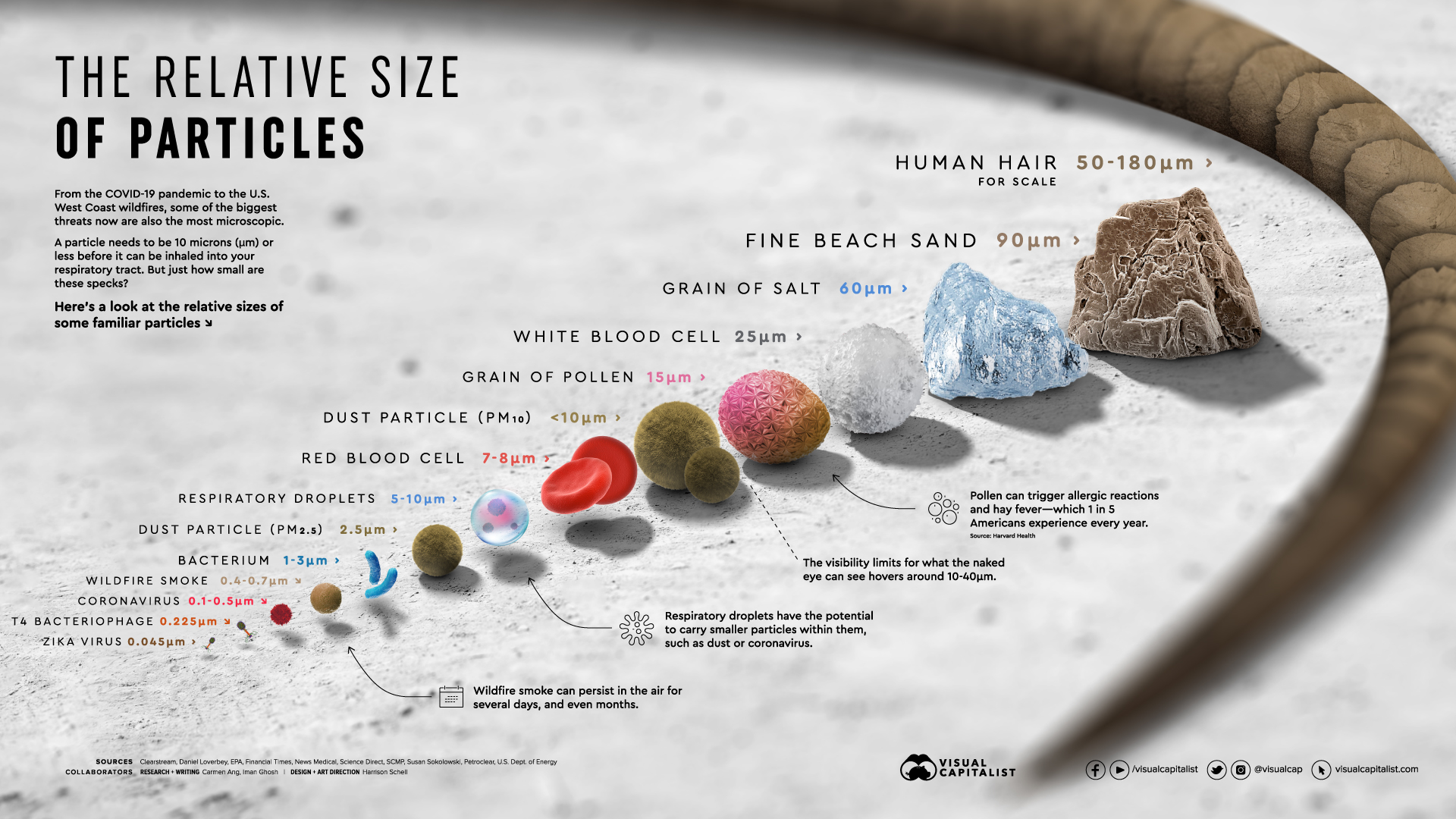Continuous improvement, 10 years of results
Today an estimated 2 billion cubic feet of air is purified using the proprietary technologies we have invested in - every hour. From tens of thousands of homes to the tallest building on earth, we're proud to be able to provide solutions that actually work in the real world. But what makes us different?

Natural Suppression
Our Polar Ionization technology can affect molecules as small as 0.000275 microns in diameter. Some of our technologies can also reduce certain viruses, bacteria, and mold on hard surfaces. Effective against allergens, fine particulates (PM2.5), formaldehyde, microbes, air pollution, chemical gases, and more.

Proven Results
Our technologies have undergone over a decade of rigorous testing and field studies by 3rd party laboratories, universities, commercial clients, and leading independent researchers. Commercial clients include world renowned five star resorts, the tallest building in the world, professional sports teams, and hospitals.

Innovative Efficiency
Our extremely compact products cover much larger spaces than competing technologies. Low energy, little to no maintenance, and whisper quiet operation set our products apart. USA designed & assembled with the highest quality components (global and/or domestic) and technology available.
Air Quality is Complex - Some Challenges Require Different Solutions
Sadly there is no "silver bullet" product or technology when it comes to air quality. Each situation is very unique. Not only do we have to consider the types of contaminants (particulates, biological threats, odors, etc.) but the concentrations of those contaminants, the ongoing sources of those contaminants, as well as the unique goals and needs of the occupants. It's our opinion that Polar Ionization provides almost a complete coverage of airborne and surface based contaminants at a high cost efficiency, but other factors like removal speed or high odor content would mean another technology is needed.
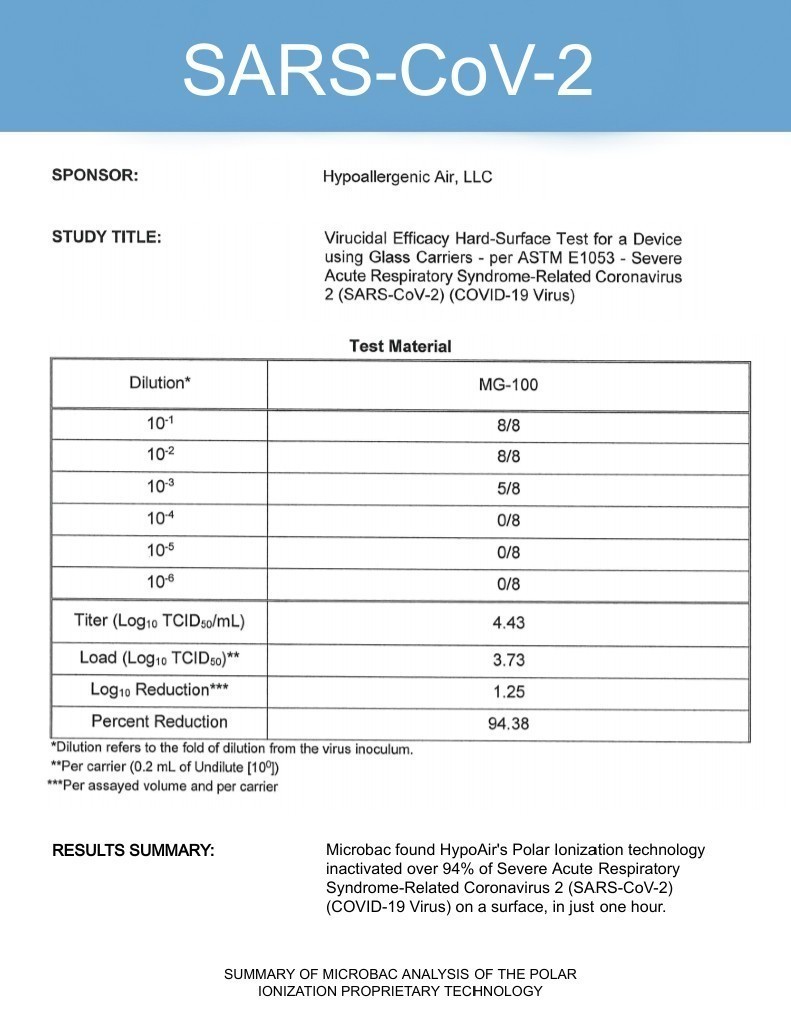
Examples of Laboratory Studies
The proprietary technologies we have invested in are backed by 15 years of laboratory, university, and "real world" commercial studies. These tests are available upon request, and cover topics including SARS-CoV-2, MERS-CoV, VOCs, Molds, MRSA, O3, TBC, HCHO, RSP, NH3, H2S, and many more. Below are a few examples. Click on the image to see a larger preview or click the link to download a larger summary of each study.
These example tests do not apply to all products sold on HypoAir.com Each Air Purifier or product uses different technologies for different applications.
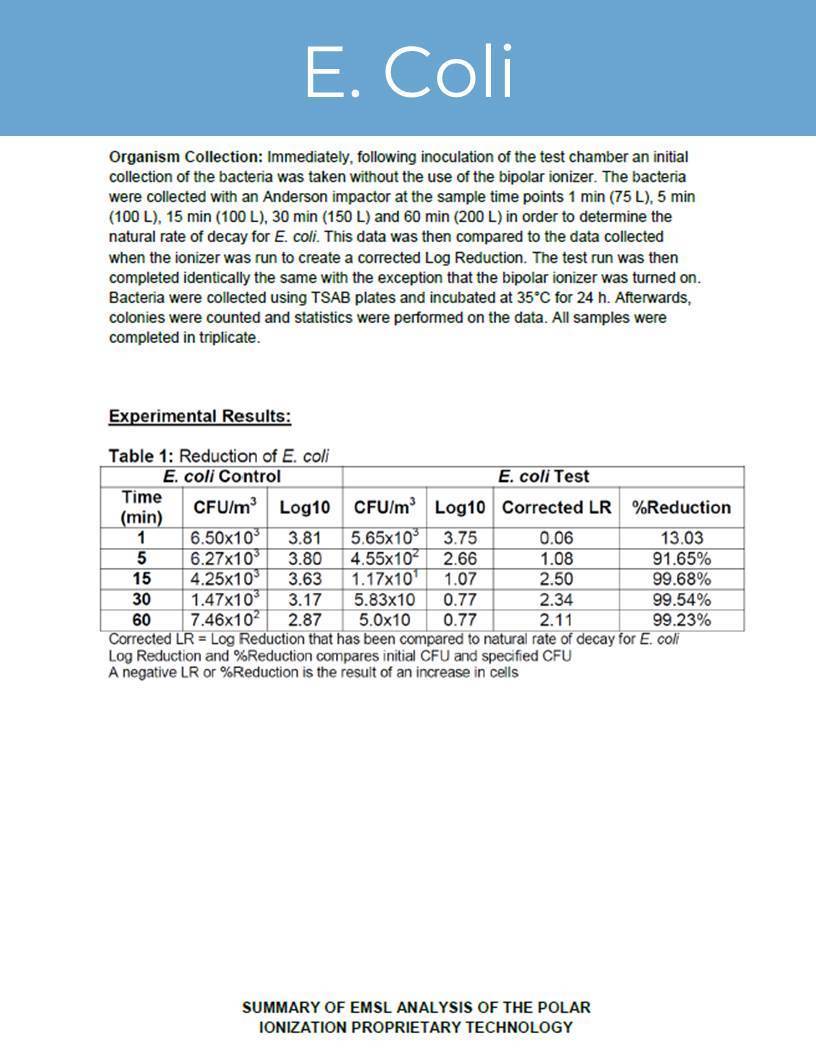

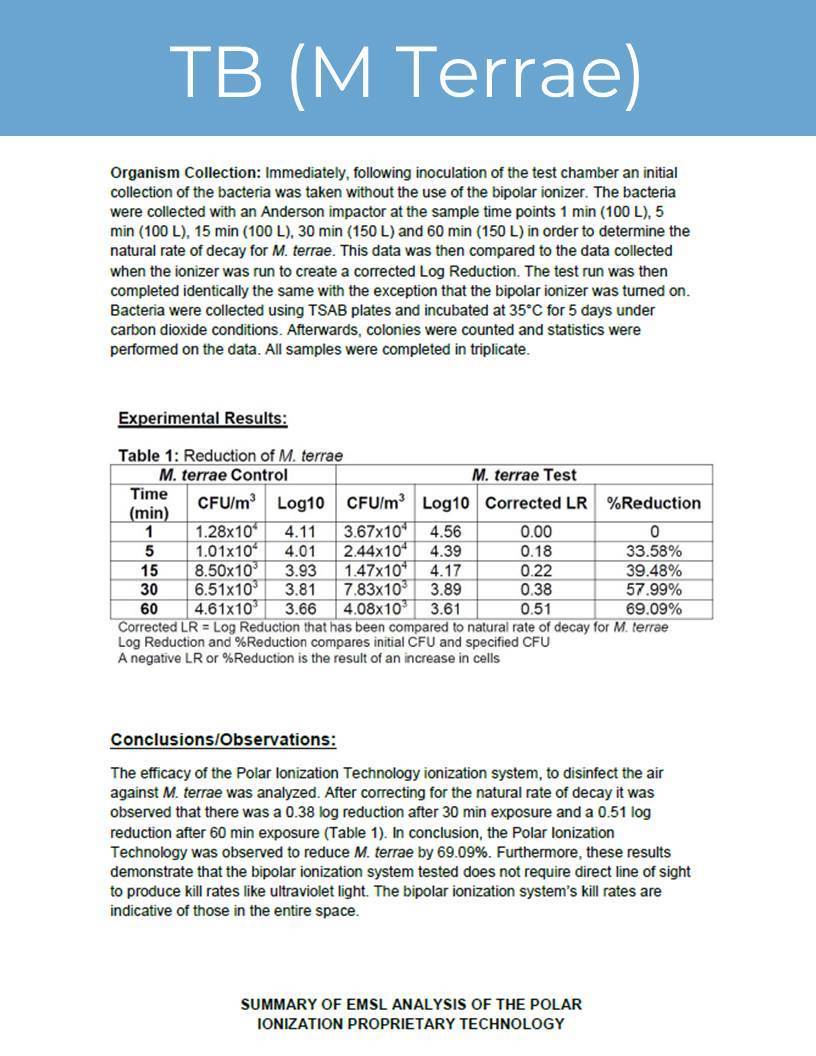
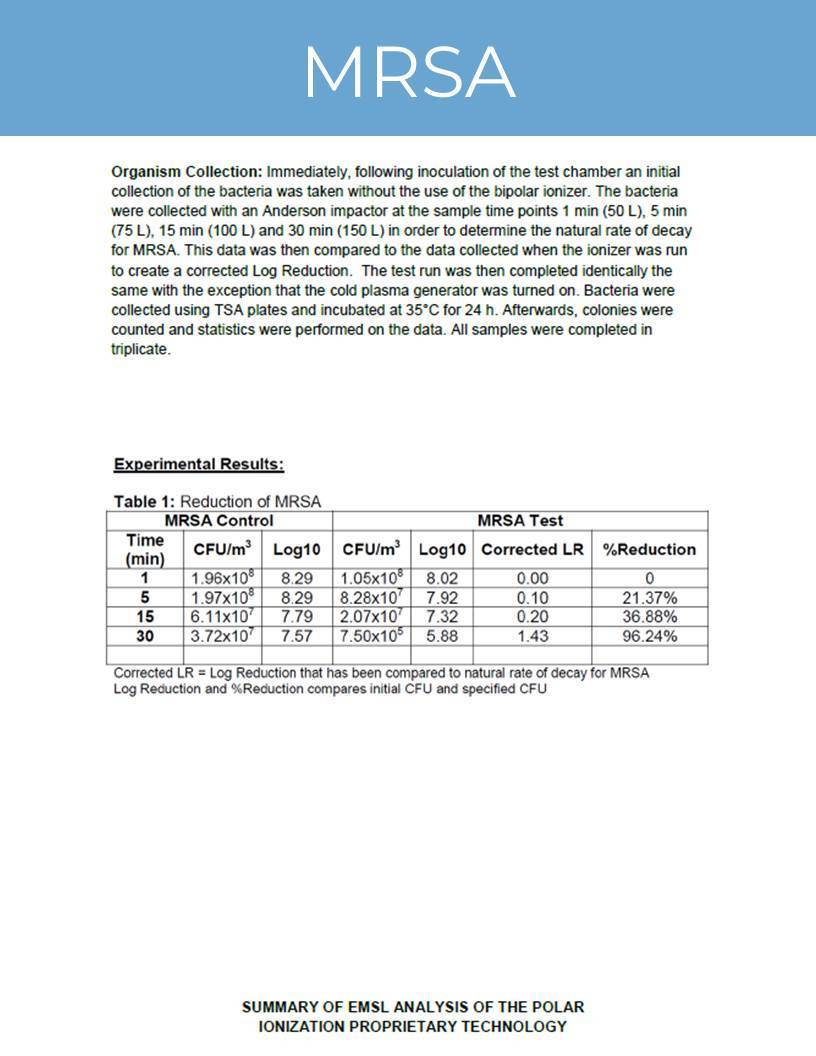
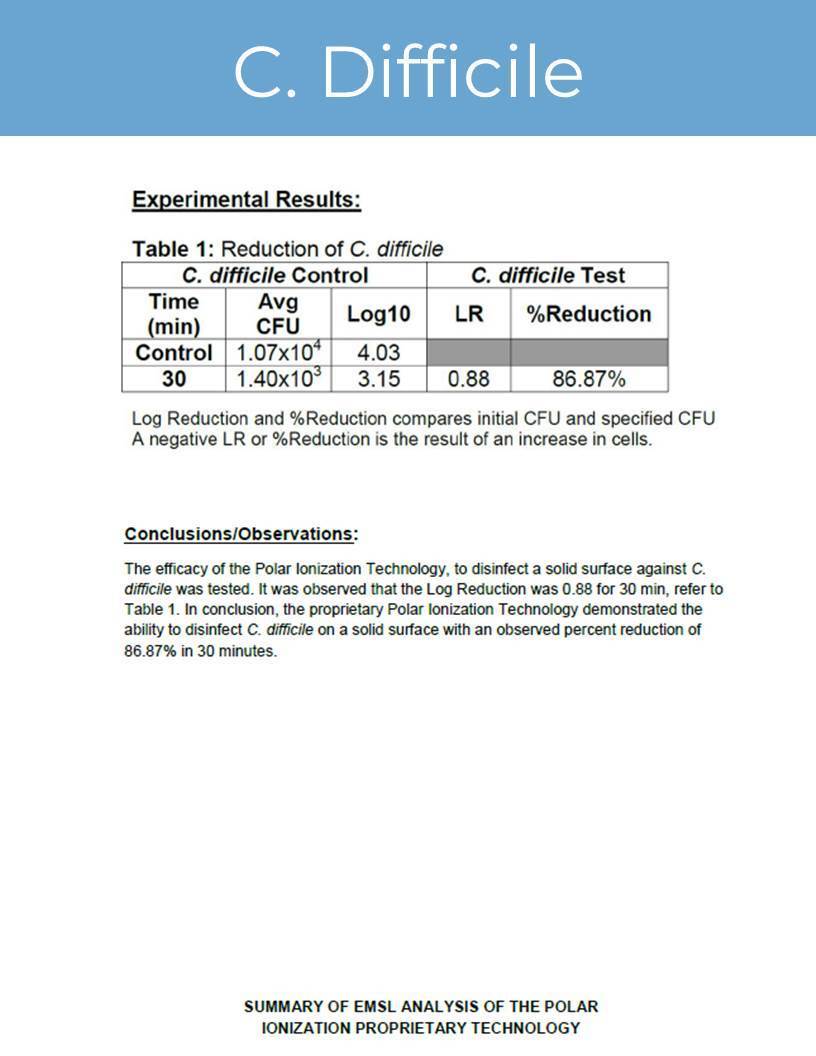
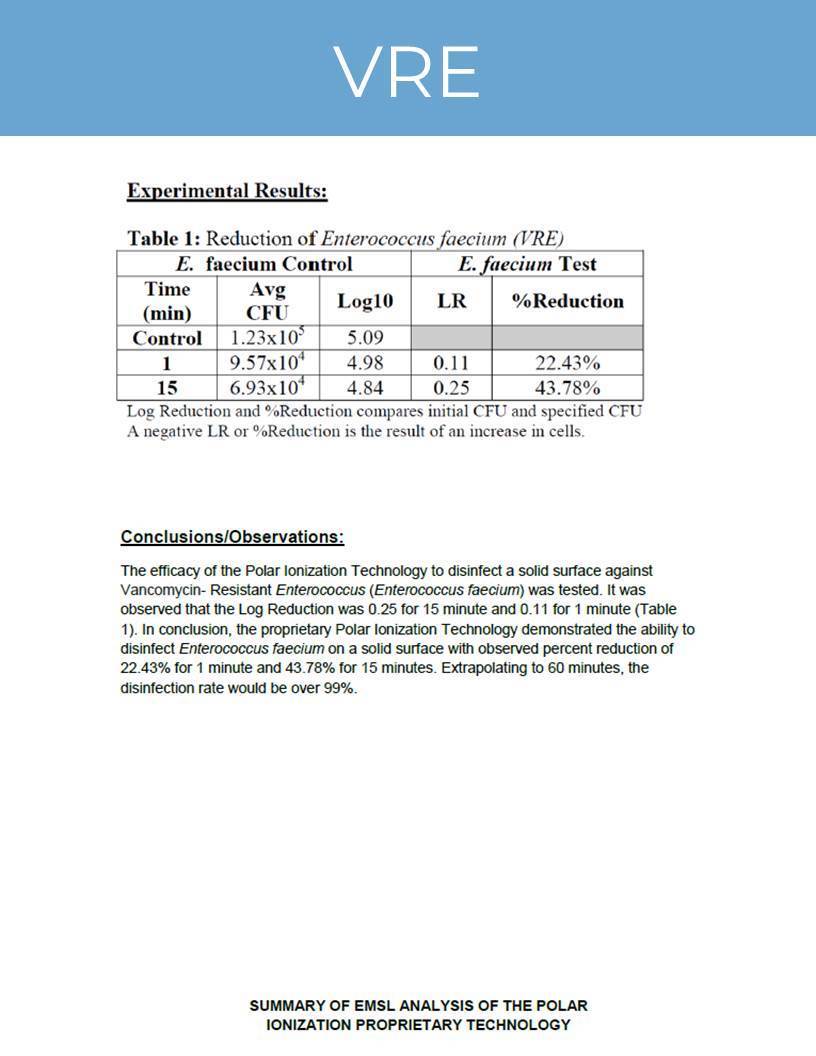
Air Quality is not "one size fits all"
Air quality is complex. No single technology or product is optimal for every situation or contaminant type (despite what some may claim). Our current array of Air Purifier products utilize between 1 and all 6 of the below technologies depending on the application. As such, not all referenced technologies are relevant for all products. Below is a simplified chart of some of the more common air purification technologies, and how we match up.
Filterless Technologies
Physical Filter Types
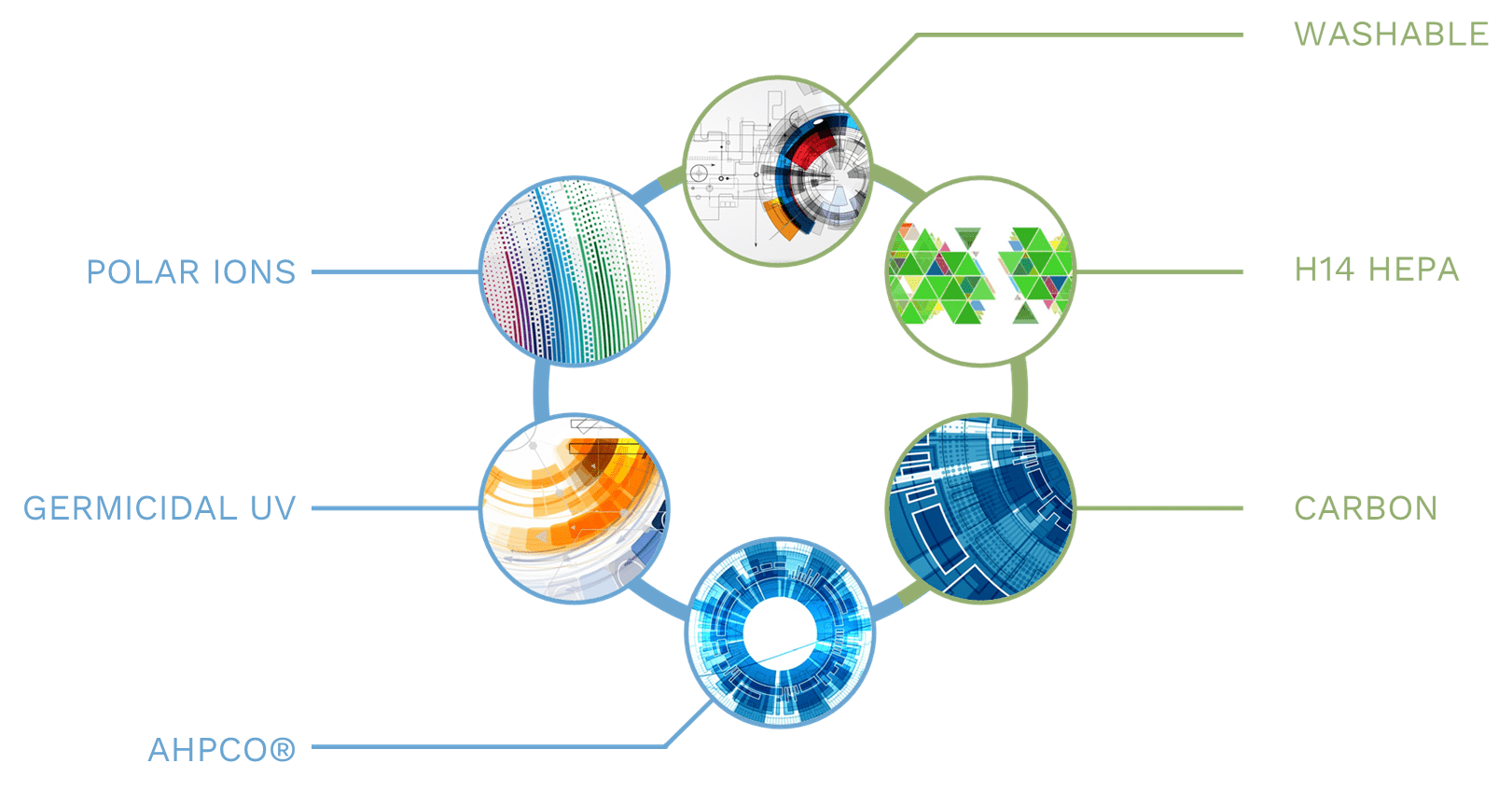
Tech | How | Strengths | Weaknesses | Coverage | Surfaces | Upkeep |
|---|---|---|---|---|---|---|
Most Filters | Air forced through a basic filter will trap large particles | Most store bought air purifiers feature filters with very little use. Some dust and large particles will be trapped | Has almost no effect on general air quality. Has no effect against odors, VOCs, biologicals, etc. | Small areas, no more than a room | Zero effect | Frequent filter replacements required. |
Negative Ions | Negative oxygen is produced using a variety of methods & quantities. | Has an effect on removing biologicals and VOCs. | Has a tendency to stick together and become ineffective. Unable to travel distances. Not effective against odors or most particulates. | Small areas, no more than a room | Possible, but not typically effective | Little to none |
Ozone Generator | Ozone (O3) is produced in high quantities using a variety of methods | Effective method to neutralize odors, chemical gases, bacteria, mold, viruses, and more. | Typically produce high concentrations of Ozone beyond safety standard limits. Often requires evacuation of the room. Can become irritating and leave an unpleasant odor. | Can remove contaminants in large areas or entire buildings. | Highly effective against viruses, bacteria, mold, and entrenched odors found on surfaces | Often requires costly and frequent bulb replacements. |
PCOwith UVGI or UV LED | UV light reacts with a metal TiO2 catalyst to produce hydroxyl radicals. | Effective at reducing bacteria, mold, viruses, and VOCs that come into contact with the catalyst surface (only air passing through its chamber) | Is only effective on the air that goes through the filter chamber. Does not remove particulate matter. Risk of incomplete oxidation. Requires slow airflow rates. Use of LED bulbs extends system life, but decreases effectiveness. | Can cover larger areas than HEPA, but typically no more than a room. HVAC installations are possible. | Zero effect | Costly and frequent bulb replacements required unless LED bulbs are used. |
True HEPA | Air forced through a true HEPA filter will trap particles, but has the most trouble with 0.3 microns (the MPPS) | Effective and proven method to reduce allergens, dust, and other particulate matter including PM 2.5. Can be placed in the HVAC system as well. | Is only effective on the air that goes through the filter chamber. Does not remove contaminants like odors and chemical gases. Fan speeds required to be effective with dense filters typically are noisy. | Can remove particulates quickly, but only in small areas. HVAC installations are possible. | Zero effect | Costly and frequent filter replacements required. |
Carbon | Chemical gasses and odors present in air forced through a carbon filter will be absorbed by the carbon and removed. | Effective and proven method to remove chemical gasses and heavy odors from the air. Can be placed in the HVAC system as well. | Is only effective on the air that goes through the filter chamber. Does not affect particulates or biologicals. Fan speeds required to be effective with dense filters typically are noisy. | Can remove odors quickly, but only in small areas. HVAC installations are possible. | Zero effect | Costly and frequent filter replacements required. |
UVGI | Ultraviolet germicidal irradiation (UVGI) is a disinfection method that uses short-wavelength ultraviolet (UV-C) light | Kills or inactivates microorganisms like bacteria, mold, and viruses. | Is only effective at short distances with direct line of sight (100% power at 1”, 25% power at just 2”, etc.). As it is unsafe for direct human exposure for prolonged periods, it must be contained in a filter chamber or the room must be evacuated. Requires slow airflow rates. | Coverage is limited to the airflow of the system they are installed in. HVAC installations are possible. | Effects any surface the light shines on in close proximity. | Costly and frequent bulb replacements required. |
AHPCO | UV light reacts with a 5 nano metal catalyst (AHPCO) producing a variety of catalytic molecules. | Effective and proven method to reduce odors, allergens, bacteria, mold, viruses, and VOCs. Does not require air to pass through its chamber in order to be effective. Removes PCO related concerns of incomplete oxidation and slow airflow rates. | Is less effective against particulate pollution than HEPA or polarized ionization. Initially takes longer than carbon filters to effect odors, but after continued use in a space is indistinguishably effective in most cases when new odors are introduced. | Can remove contaminants in large areas or entire buildings. HVAC installations are possible. | Highly effective against viruses, bacteria, mold, and entrenched odors found on surfaces | Long Life bulb coating reduces replacement frequency of UV bulbs. 1-2 years depending on unit. |
Polar Ions | Carbon brush nodes split water vapor in the ambient air into Polarized ions which are proactively dispersed. | Effective and proven method to reduce allergens, dust, PM 2.5, bacteria, mold, viruses, static, and VOCs. Does not require air to pass through its chamber in order to be effective. Removes concern of incomplete oxidation and slow airflow rates. | While effective over time, it is less powerful against heavy VOCs and Odors than AHPCO or Carbon filtration. | Can remove contaminants in large areas or entire buildings. HVAC installations are possible. | Highly effective against viruses, bacteria, and mold found on surfaces. | Zero replacement parts for life. Nodes should be gently dusted with a flick of the finger every few months. |
We know there are a lot of claims out there and a LOT of air purifiers that don't work. Many if not most of our customers have been let down by another company that is spending a lot of money on marketing, but not as much on hard science. We're happy to answer your questions related to any specific product or technology.
AHPCO Technology's History: NASA’s answer to the air quality challenges of deep space was a technology that utilizes Photocatalytic Oxidation (PCO). It had to be compact, little to no maintenance, energy efficient, and had to actively eliminate a broad spectrum of contaminants. We have invested in and greatly improved the original NASA PCO with the Advanced Hydrated PhotoCatalytic Oxidation (AHPCO®) nanotechnology.
How it works: UVC light destroys microorganisms as they pass by. Oxidizing Catalytic Molecules are then formed from water vapor when the UVC rays excite the AHPCO nanometal Catalyst. Clean-Tech does not have a UV light but splits water vapor in the ambient air into Polarized Catalytic Molecules which are proactively dispersed throughout the ambient air. Catalytic Molecules actively seek out pollutants and break them apart at a molecular level. Contaminants are neutralized as they are destroyed. Oxidizing Catalytic Molecules are more effective at neutralizing VOCs, while Polarized Catalytic Molecules have a clustering effect that is extremely effective at causing particulates to become heavy and drop out of the air.

Catalytic molecules and Ozone:
Indoor Air Quality (IAQ) solutions that only use ozone must produce larger amounts of ozone to become effective at all. These high ozone levels can become irritating, odorous, dangerous, and degrading on equipment. Hypoallergenic Air is not an ozone generator. As you can see in the chart from a third party testing agency (CMA), our technology is able to quickly and effectively reduce large amounts of VOCs without increasing ambient ozone. Zero parts per billion by volume (ppbv) of Ozone were present in the ambient air before and during use of our technology.
Our proprietary AHPCO and polarized ionization technologies have multiple modes of action. Minimal ozone production is a very small part of the chemical reaction process that leads to the creation of hydroperoxides in some of our units. Each of our standard residential units are designed to produce less than 50 ppb (0.05 ppm) inside our units, but as seen in the above example using a powerful commercial nano induct AHPCO unit, the ozone levels in the ambient air are far lower. The AO3000X is the only exception as a light commercial unit which is designed for extreme residential contaminant situations and produces a maximum of 70 ppb. The California Air Resource Board (CARB) is one the strictest ozone regulatory agencies in the world which certifies products that produce less than 50 ppb peak ozone production 1 cm from the device as safe. To put this into perspective you can review the up to date hourly ozone averages of our most pristine national parks in the US which range from about 17-68 ppb at the time of this writing. See the data for yourself at the official National Park Service website here (www.nps.gov). Essentially what that means is the ozone in the ambient air (what we breath) when using our technology properly should be roughly equivalent to what you'd be breathing on a hike in Denali National Park, Alaska. Ozone (O3) is like many things in that it's the dosage or concentration that dictates an issue. Humans cannot live without oxygen (O2), but did you know too much oxygen can be toxic to humans? You can also have issues if you consume too much of an extremely healthy thing like carrots, Omega-3, cruciferous vegetables (broccoli, kale, etc.), nutmeg, brazil nuts, cinnamon, and yes, even coffee. Moderation and balance is key. The important thing to consider with our technology is we replicate healthy levels of catalytic molecules found in the natural air outside, all while reducing the explicitly dangerous levels of contaminants inside (VOCs, chemical gases, bacteria, molds, particulates, viruses, etc.).
Various Performance & Safety Studies (not applicable to all products sold):

(full studies available upon request)
CMA’s Multi-Containment Indoor Report:
CMA’s Multi-Containment Indoor Air Quality (IAQ) Report: Over the course of 3 hours, the Nano Induct maintained a 0.000 ppmv of O3 while dramatically reducing Total Bacteria Count (TBC) by 82.7%, Total Volatile Organic Compounds (TVOC) by greater than 99%, formaldehyde (HCHO) by 98.5%, Respiratory Suspended Particulate (RSP) by 35.5%, Ammonia (NH3) by 73.3%, and Hydrogen Sulfide (H2S) by greater than 97%.
EMSL Analytical Various Studies
C. difficile Surface Reduction: Technology was tested for its ability to disinfect (kill) bacteria on a solid surface. The testing was conducted in the Cinnaminson Microbiology Laboratory. Contact time 30 min, reduction 86.87%
Airborne TB Efficacy – M. Terrae Test: Mycobacterium terrae (M. terrae) is commonly used as a surrogate test for Mycobacterium turberculosis. In conclusion, the technology was observed to reduce M. terrae by 69.09%. Furthermore, these results demonstrate that the bipolar ionization system tested does not require direct line of sight to produce kill rates like ultraviolet light. The bipolar ionization system’s kill rates are indicative of those in the entire space.
VRE Surface Reduction: The efficacy of the technology to disinfect a solid surface against Vancomycin- Resistant Enterococcus (Enterococcus faecium) was tested and saw 43.78% reduction in the first 15 minutes. Their extrapolated conclusion was the disinfection rate would be over 99% after 60 minutes.
RTI International’s Microbiological Analysis:
RTI International's Dynamic Microbiological Test Chamber's extrapolated results showed that the unit could efficiently clear 25,000 cubic feet of Staphylococcus epidermidis, Aspergillus versicolor and Penicillium chrysogenum in a matter of hours and the resilient Mycobacterium parafortuitum in only a few days.
KTR's Comprehensive Bacterial Reduction:
The Korea Testing and Research Institute conducted a specialized study on our technology. They saw reductions of 99.9% against E. Coli, S. Typhimurium (salmonella), MRSA, L. Monocytogenes (listeria), B. Subtilis, P. Aeruginosa, and S. Aureus.
West Texas A&M University various studies:
Human Safety Analysis: Human red blood cells, human cell culture, and plant cells exposed to AHPCO showed complete safety to complex life (zero cytological damage to the RBC and WBCs).
CA-MRSA analysis at Baptist Saint Anthony’s Hospital (BSA): saw 65% reductions in MRSA during the first 72 hours.
Reduction of Fungal Aeroallergens and Pollutants: found significant differences in microbial spore and pollen counts of allergenic taxa in the indoor air and found that after 72 hours of use there were no microflora or propagules left in the air.
Evaluation of VOC Reductions in 1 hour All units saw significant reductions in the first hour of use including the Mobile (30-40%), the AO3000X (40-50%) and the HCT nano Induct (85%) of Acetic acid, Propionic acid, Isobutyric acid, Butyric acid, Isovaleric acid, Valeric acid, Hexanoic acid, Phenol and Pcresol.
Foodborne Pathogens Study: The AO Food Chamber showed zero microbial colonies on the tested food units, compared to the growing microflora in all controls. Surface swab cultures from the AO samples showed no growth of any microflora compared to all control groups which exhibited microflora growth.
Mold Reduction Study in Coulter Animal Hospital: Study showed 65.71% reduction in mold growth on the petri-dishes and 68.1% reduction in bacterial concentration (majority conidia and hyphae from Alternaria, spores from Dreschlera, Cladosporium and Stachybotrys chartarum).
LAWN Environmental Protection Ltd:
Analysis of IAQ of Buses: Air samples after using our products now qualified for Excellent Air Quality for HCHO (46-77.5% reductions) and TVOC (66-82% reductions). Bacteria control was Excellent prior to the trial but still saw 22% reductions.
Kitasato Research Center:
Kitasato Research Center for Environmental Science in Japan is a renowned source of virus research. They conducted a study in a 25 m3 room. They found 99.5% reduction of the airborne virus after just 3 hours.
RESIDENTIAL
- Bedrooms & Nurseries
- Kitchens
- Pets and Allergies
- Cars, Offices, and Travel
- Whole House Purification
COMMERCIAL
- Resorts & Casinos
- Hospitals
- Food Industry
- Office Buildings
- Energy Sustainability
HVAC
- Air Handler Solutions
- Induct installations
- PTAC, VTAC, and more
- Residential & Commercial
- Exhaust Mitigation
REFRIGERATION
- Ice Machines
- Reefer Transportation
- Cold Storage
- Refrigerators
- Coil Cleaning

